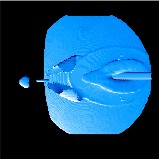 In modeling the hypersonic jets ejected by young stars,
one can play with two basic ideas:
1. the observed emission is due to the self-interaction occurring
within an outflow ejected in a time-dependent way,
2. the observed structures result from the interaction between
the jet and the surrounding environment.
Even though adventurous 1.5 decades ago, the first of these
possibilities has now become the favored scenario for modeling
HH jets. In particular, new observations and modeling of the
two well studied objects HH 34 and HH 111 appear to leave little
doubt that this scenario is indeed correct at least for some
HH jets.
The interaction of jets with the "outside world" (once the favored
scenario for explaining the observed HH emission, but currently
not in the peak of fashion) is an interesting problem, and is clearly
occurring in some HH jets. In particular, there are jets that slam into
dense obstacles, jets that are swept sideways by a moving environment,
and jets that are photo-ionized by external ionizing photon sources.
Different examples of these kinds of interactions will be discussed
In modeling the hypersonic jets ejected by young stars,
one can play with two basic ideas:
1. the observed emission is due to the self-interaction occurring
within an outflow ejected in a time-dependent way,
2. the observed structures result from the interaction between
the jet and the surrounding environment.
Even though adventurous 1.5 decades ago, the first of these
possibilities has now become the favored scenario for modeling
HH jets. In particular, new observations and modeling of the
two well studied objects HH 34 and HH 111 appear to leave little
doubt that this scenario is indeed correct at least for some
HH jets.
The interaction of jets with the "outside world" (once the favored
scenario for explaining the observed HH emission, but currently
not in the peak of fashion) is an interesting problem, and is clearly
occurring in some HH jets. In particular, there are jets that slam into
dense obstacles, jets that are swept sideways by a moving environment,
and jets that are photo-ionized by external ionizing photon sources.
Different examples of these kinds of interactions will be discussed
Tuesday, March 11th at 4:00 p.m.
All seminars are at 4:00 PM on Tuesdays, in the seminar room
on the second floor of Dearborn Observatory
Refreshments will be served at 3:30
|






